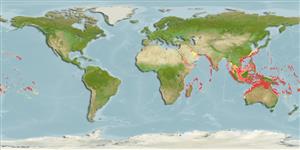分类 / Names
俗名 | 同种异名 | Catalog of Fishes(属, 种) | ITIS | CoL | WoRMS | Cloffa
Teleostei >
Eupercaria/misc (Various families in series Eupercaria) >
Lethrinidae (Emperors or scavengers) > Lethrininae
Etymology: Lethrinus: Greek, lethrinia, a fish pertaining to genus Pagellus.
More on author: Klunzinger.
Environment: milieu / climate zone / depth range / distribution range
生态学
海洋 礁区鱼类; 非迁移的; 深度上下限 0 - 150 m (Ref. 2295). 热带; 31°N - 28°S, 30°E - 134°W
Indo-Pacific: Red Sea, East Africa and the central Indian Ocean to the Marquesas Islands, north to the Ryukyu Islands.
印度-太平洋: 红海, 东非与印度洋中部到马可萨斯岛岛, 北至琉球群岛。
大小 / 重量 / 年龄
Maturity: Lm ? range ? - ? cm
Max length : 70.0 cm FL 雄鱼/尚未辨别雌雄; (Ref. 40637); common length : 59.0 cm SL 雄鱼/尚未辨别雌雄; (Ref. 37816); 最大体重: 5.4 kg (Ref. 40637)
背棘 (总数): 10; 背的软条 (总数): 9; 臀棘 3; 臀鳍软条: 8. This species is distinguished by the following characters: body moderately elongate, its depth 2.8-3.5 times in standard length; head length 1-1.2 times in body depth, 2.6-3 times in SL, dorsal profile near eye convex; snout length about 1.7-2.5 times in HL, measured without the lip the snout is 0.8-0.9 times in cheek height, its dorsal profile nearly straight, snout angle relative to upper jaw between 45° and 60°; interorbital space distinctly concave; posterior nostril a longitudinal or vertical oblong opening, closer to orbit than anterior nostril; eye situated close to dorsal profile, its length 2.8-5.1 times in HL; cheek height 2.3-3.4 times in HL; lateral teeth in jaws conical; outer surface of maxilla smooth; D X, 9 with the third dorsal-fin spine the longest, its length 2-2.8 times in body depth; A III, 8 with the first soft ray usually the longest, its length approximately equal to or shorter than length of base of soft-rayed portion of anal fin and 1.3-1.7 times in length of entire anal-fin base; pectoral-fin rays 13; pelvic-fin membranes between rays closest to body with dense melanophores; cheek without scales; 47-48 lateral-line scales; 4 ½ scale rows between lateral line and base of middle dorsal-fin spines; 15-16 scale rows in transverse series between origin of anal fin and lateral line; usually 15 rows in lower series of scales around caudal peduncle; 5-8 scales in supratemporal patch; inner surface of pectoral fins without scales; posterior angle of operculum fully scaly. Colour of body yellowish grey with scattered irregular dark spots; lips yellowish, upper lip more intense; a red spot at upper base of pectoral fins; fins bluish grey and mottled, bases of fins lighter and edges of dorsal and caudal fins reddish (Ref. 114226).
身体是黄灰色的有分散的不规则的深色斑点; 唇淡黄色的, 上嘴唇更密集; 在胸鳍的上面基底的一个红色的斑点。 鳍是蓝灰色而有斑点的,鳍的基底是颜色淡的,而且背鳍与尾鳍的边缘是淡红的。
Occurs in small groups over seagrass beds, sand and rubble areas of coral reefs, deep channels, and lagoons. Usually found in shallow water to depths of 150 m. Usually seen solitary but sometimes swims in small groups. Juveniles in seagrass beds (Ref. 48635). Feeds mainly on crustaceans, fishes, and echinoderms. Caught mostly with handline, traps,
and trawl (Ref. 114226). Minimum depth reported taken from Ref. 128797.
形成小群鱼群海草床之上,珊瑚礁,深的峡道与泻湖的沙子与碎石区。 通常发现于浅水区。 通常单独的被看到但是有时群游于小群鱼群中。 稚鱼在海草床。 (参考文献 48635) 主要吃甲壳动物,鱼与棘皮动物。
Life cycle and mating behavior
成熟度 | 繁殖 | 产卵场 | 卵 | 孕卵数 | 仔鱼
印度-太平洋: 红海, 东非与印度洋中部到马可萨斯岛岛, 北至琉球群岛。
Carpenter, K.E. and G.R. Allen, 1989. FAO Species Catalogue. Vol. 9. Emperor fishes and large-eye breams of the world (family Lethrinidae). An annotated and illustrated catalogue of lethrinid species known to date. FAO Fish. Synop. 125(9):118 p. Rome: FAO. (Ref. 2295)
人类利用
渔业: 商业性; 游钓鱼种: 是的
工具
特别资料
下载 XML
网络资源
Estimates based on models
Preferred temperature (Ref.
123201): 24.5 - 29, mean 27.9 °C (based on 1520 cells).
Phylogenetic diversity index (Ref.
82804): PD
50 = 0.5000 [Uniqueness, from 0.5 = low to 2.0 = high].
Bayesian length-weight: a=0.01549 (0.01034 - 0.02321), b=2.96 (2.84 - 3.08), in cm total length, based on LWR estimates for this species & Genus-body shape (Ref.
93245).
营养阶层 (Ref.
69278): 3.8 ±0.0 se; based on diet studies.
回复力 (Ref.
120179): 低的, 最小族群倍增时间4.5 - 14 年 (K=0.14-0.30).
Prior r = 0.33, 95% CL = 0.22 - 0.49, Based on 2 stock assessments.
Fishing Vulnerability (Ref.
59153): High vulnerability (57 of 100).
Climate Vulnerability (Ref.
125649): Very high vulnerability (76 of 100).
Nutrients (Ref.
124155): Calcium = 30.6 [21.9, 41.4] mg/100g; Iron = 0.718 [0.493, 0.992] mg/100g; Protein = 20.2 [17.5, 22.3] %; Omega3 = 0.133 [0.100, 0.174] g/100g; Selenium = 55.2 [30.8, 81.2] μg/100g; VitaminA = 28.6 [6.3, 148.6] μg/100g; Zinc = 1.88 [1.47, 2.31] mg/100g (wet weight); based on
nutrient studies.
